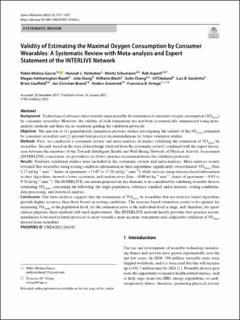| dc.contributor.author | Molina-Garcia, Pablo | |
| dc.contributor.author | Notbohm, Hannah L. | |
| dc.contributor.author | Schumann, Moritz | |
| dc.contributor.author | Argent, Rob | |
| dc.contributor.author | Hetherington-Rauth, Megan | |
| dc.contributor.author | Stang, Julie | |
| dc.contributor.author | Bloch, Wilhelm | |
| dc.contributor.author | Cheng, Sulin | |
| dc.contributor.author | Ekelund, Ulf | |
| dc.contributor.author | Sardinha, Luis B. | |
| dc.contributor.author | Caulfield, Brian | |
| dc.contributor.author | Brønd, Jan Christian | |
| dc.contributor.author | Grøntved, Anders | |
| dc.contributor.author | Ortega, Francisco B. | |
| dc.date.accessioned | 2022-06-30T12:58:09Z | |
| dc.date.available | 2022-06-30T12:58:09Z | |
| dc.date.created | 2022-05-12T13:06:14Z | |
| dc.date.issued | 2022 | |
| dc.identifier.citation | Sports Medicine. 2022, 52(7), Side 1577-1597. | en_US |
| dc.identifier.issn | 0112-1642 | |
| dc.identifier.uri | https://hdl.handle.net/11250/3001802 | |
| dc.description | This article is licensed under a Creative Commons Attribution 4.0 International License, which permits use, sharing, adaptation, distribution and reproduction in any medium or format, as long as you give appropriate credit to the original author(s) and the source, provide a link to the Creative Commons licence, and indicate if changes were made. The images or other third party material in this article are included in the article's Creative Commons licence, unless indicated otherwise in a credit line to the material. If material is not included in the article's Creative Commons licence and your intended use is not permitted by statutory regulation or exceeds the permitted use, you will need to obtain permission directly from the copyright holder. | en_US |
| dc.description.abstract | Background: Technological advances have recently made possible the estimation of maximal oxygen consumption (VO2max) by consumer wearables. However, the validity of such estimations has not been systematically summarized using meta-analytic methods and there are no standards guiding the validation protocols.
Objective: The aim was to (1) quantitatively summarize previous studies investigating the validity of the VO2max estimated by consumer wearables and (2) provide best-practice recommendations for future validation studies.
Methods: First, we conducted a systematic review and meta-analysis of studies validating the estimation of VO2max by wearables. Second, based on the state of knowledge (derived from the systematic review) combined with the expert discussion between the members of the Towards Intelligent Health and Well-Being Network of Physical Activity Assessment (INTERLIVE) consortium, we provided a set of best-practice recommendations for validation protocols.
Results: Fourteen validation studies were included in the systematic review and meta-analysis. Meta-analysis results revealed that wearables using resting condition information in their algorithms significantly overestimated VO2max (bias 2.17 ml·kg−1·min−1; limits of agreement − 13.07 to 17.41 ml·kg−1·min−1), while devices using exercise-based information in their algorithms showed a lower systematic and random error (bias − 0.09 ml·kg−1·min−1; limits of agreement − 9.92 to 9.74 ml·kg−1·min−1). The INTERLIVE consortium proposed six key domains to be considered for validating wearable devices estimating VO2max, concerning the following: the target population, reference standard, index measure, testing conditions, data processing, and statistical analysis.
Conclusions: Our meta-analysis suggests that the estimations of VO2max by wearables that use exercise-based algorithms provide higher accuracy than those based on resting conditions. The exercise-based estimation seems to be optimal for measuring VO2max at the population level, yet the estimation error at the individual level is large, and, therefore, for sport/clinical purposes these methods still need improvement. The INTERLIVE network hereby provides best-practice recommendations to be used in future protocols to move towards a more accurate, transparent and comparable validation of VO2max derived from wearables. | en_US |
| dc.language.iso | eng | en_US |
| dc.subject | exercise | en_US |
| dc.subject | exercise methods | en_US |
| dc.subject | exercise test | en_US |
| dc.subject | humans | en_US |
| dc.subject | oxygen consumption | en_US |
| dc.subject | sports | en_US |
| dc.subject | wearable electronic devices | en_US |
| dc.title | Validity of estimating the maximal oxygen consumption by consumer wearables: A systematic review with meta-analysis and expert statement of the INTERLIVE network | en_US |
| dc.type | Peer reviewed | en_US |
| dc.type | Journal article | en_US |
| dc.description.version | publishedVersion | en_US |
| dc.rights.holder | © The Author(s) 2022 | en_US |
| dc.source.pagenumber | 1577-1597 | en_US |
| dc.source.volume | 52 | en_US |
| dc.source.journal | Sports Medicine | en_US |
| dc.source.issue | 7 | en_US |
| dc.identifier.doi | 10.1007/s40279-021-01639-y | |
| dc.identifier.cristin | 2023916 | |
| dc.description.localcode | Institutt for idrettsmedisinske fag / Department of Sports Medicine | en_US |
| cristin.ispublished | true | |
| cristin.fulltext | original | |
| cristin.qualitycode | 1 | |
